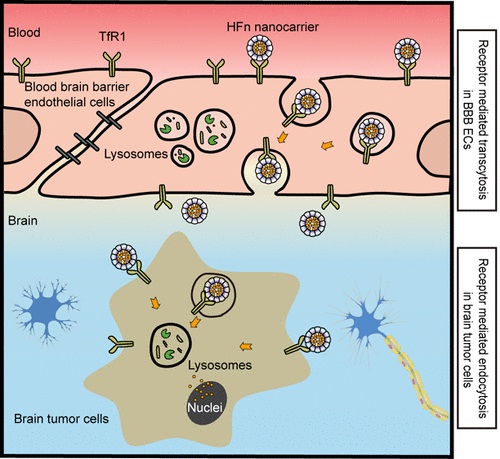Ferritin Nanocarrier Traverses the Blood Brainbarrier and Kills Glioma
A study entitled ‘Ferritin Nanocarrier Traverses the Blood Brain Barrier and Kills Glioma’ was published online in the journal ACS Nano on April 3, 2018.This paper reported for the first time that human H-ferritin nanocarriers both successfully traversed the blood-brain barrier and specifically killed glioma tumor cells located in the brain. This work is another novel finding by Prof. Yan’s group among a series of related studies on the properties of ferritin nanocarriers and their applications in biomedicine, following theirprevious reportson the tumor targeting ability of ferritin and its application in in vitro tumor pathological diagnosis (Nature Nanotechnology, 2012), in vivotumor targeted therapy (PNAS,2014) and in vivo tumor multimode imaging (ACS Nano, 2016).
The blood-brain barrier (BBB) is a natural barrier that maintains central nervous system homeostasis and protects brain tissue from metabolites. However, while protecting the nervous system, the blood-brain barrier also makes it impossible for almost 100% of macromolecular drugs and 98% of small molecules to reach the brain, leading to a lack of effective treatments for most central nervous system diseases, such as malignant tumors. Therefore, the biggest challenge of clinical treatment for these diseases is how to effectively deliver probes or drugs through the blood-brain barrier.
Receptor mediated transcytosis (RMT) is one of the most effective ways to allow the crossing of biological macromolecular drug through the BBB. Among them, transferrin receptor 1 (TfR1) is one of the most representative receptors for endocytosis. Due to the high expression level of TfR1 in both BBB endothelial cells (BBB ECs) and malignant brain tumor cells, TfR1 targeting drugs can be used to penetrate the BBB and subsequentlyenriched in brain's malignant brain tumor.However, due to the high affinity of the commonly known anti-TfR1 antibodies or ligands, most of them will likely degrade in the lysosome of the BBB ECs, unable to reach the lesion through the BBB.
In the attempt to find the ideal RMT targeting ligand, the authors found for the first time that the human H-ferritin (HFn) nanocarriersare able to specifically bind BBB ECs, traverse the BBB, and target gliomatumor cells via interaction with their receptors (e.g. TfR1). In the study, upon entering BBBECs, HFn nanocarrier accumulated in endosomes, but notin lysosomes, resulting in its effective crossing of the BBB. Incontrast, upon entering glioma cells, nearly all of the HFnaccumulated in the lysosomal compartment. This characteristic makes ferritin an ideal drug carrier for the treatment of malignant brain tumors. In normal healthy mice, the authors confirmed that ferritin can effectively penetrate intact BBB. In mice with glioma tumor in situ, HFn can be enriched in the tumor region and inhibit the growth of malignant brain tumor after traversing the BBB. In addition, animal safety experiment and pathological analysis showed that HFn nanocarriers specifically killed malignant brain tumor, but does not damage normal brain tissue.This research shows that the suitable binding affinity of HFn and TfR1, the symmetry structure of multiple binding sites and the ideal nanometer size effect may be the reasons why HFn nanocarriers traverse the BBBand specifically target the glioma tumors.
In light of the newly discovered characteristics of HFn, along with its easy preparation, good biocompatibility and high drug loading, HFnis an ideal nano-drug carrier for the targeted treatment of malignant brain tumors as well as a potential platform for other types of central nervous system diseases.
Professor YAN Xiyun and Associate Professor FAN Kelong at the Institute of Biophysics, CAS, in cooperation with Professor TIAN Jie at the Institute of Automation, CAS, are corresponding authors. FAN Kelong and ZHOU Meng from Prof. Yan’s group and JIA Xiaohua from Prof. Tian’s group are the co-first authors of this work. This research was supported by National Natural Science Foundation of China, the Strategic Priority Research Program, the Key Research Program of Frontier Sciences of CAS, National Key Research and Development Program of China,and Young Elite ScientistSponsorship Program by CAST.
Article link: https://pubs.acs.org/doi/10.1021/acsnano.7b06969

Ferritin Nanocarrier Traverses the Blood Brainbarrier and Kills Glioma (FAN Kelong et al., ACS Nano, 2018)
Contact: YAN Xiyun
Institute of Biophysics, Chinese Academy of Sciences
Beijing 100101, China
Phone: 86-10-64888584
Email: yanxy(AT)ibp.ac.cn

